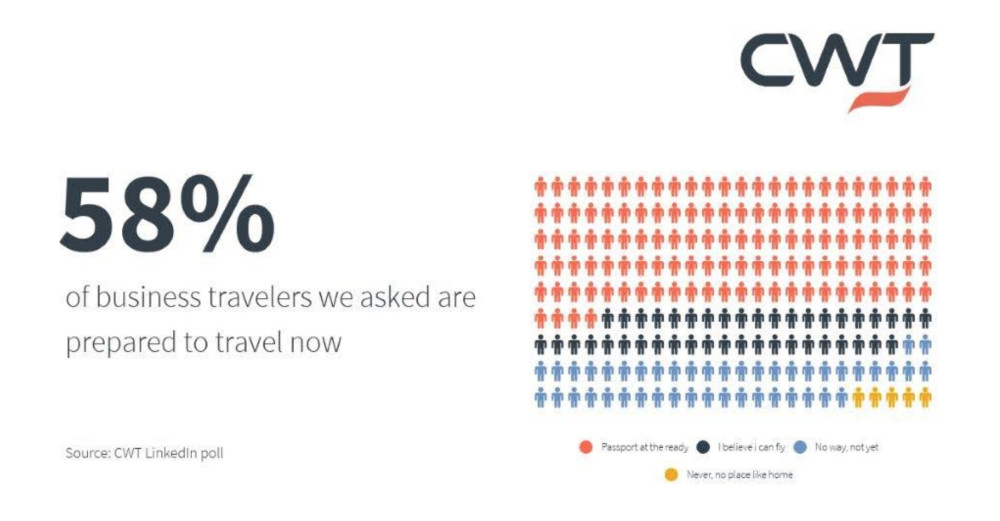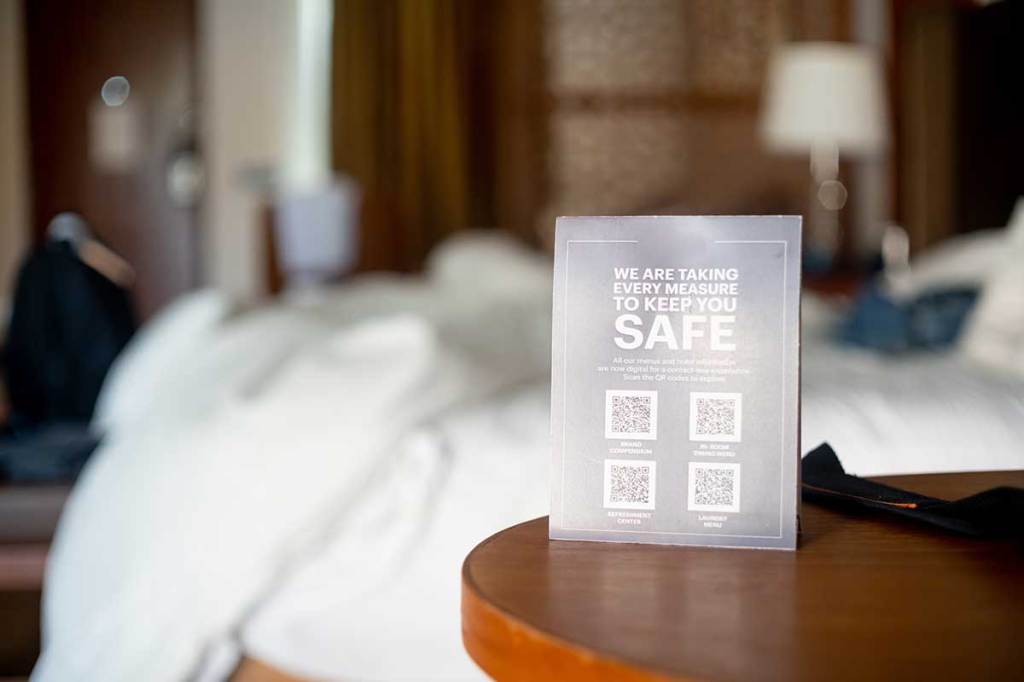Introducing the latest myCWT product and service enhancements
Building on our digital, omnichannel myCWT platform, our new products and services will simplify travel management for you and your employees – anytime, anywhere, anyhow.
Note: Featured services may not be available in your country at this time. Please reach out to your CWT representative for more details.
Hear from Chief Product Officer, Erica Antony as she shares the key product highlights of 2024, along with the key areas driving innovation.
-

2040: Baseline, Boom or Bust
As we enter an era of rapid transformation and unprecedented challenges, it is essential for travel managers, meeting & event planners, and corporate decision-makers to look ahead and frame our current strategic thinking with a clear vision of the future. Business travel and meetings and events (M&E) are poised for significant change over the next decade and a half, driven by a complex interplay of sustainability goals, technological advancements, evolving work models, and geopolitical dynamics.
In this paper to mark the 10th anniversary of our Global Business Travel Forecast, we explore, for the first time, a long-term vision of the future and potential trajectories through three distinct scenarios, each offering insights into how these forces should affect policy-making, budgeting and priorities. By examining these scenarios, we can better understand the diverse possibilities that lie ahead and the strategic imperatives required to thrive in each potential future.
Based on trajectory data analysis and interviews with industry leaders, behaviorists and climate tech founders, this forward-looking approach enables us to anticipate changes, strengthen our strategies, and make informed decisions that align long-term objectives. It is through this lens of foresight and adaptability that we can build resilience, seize opportunities, and navigate the complexities of the future.
We invite you to reflect on the insights presented, and consider how your organization can prepare for the opportunities and challenges that lie ahead. Together we can ensure that travel and meetings remain catalysts for growth, scalability and sustainable practices.
- Scenario development is both an art and a science
- Megatrends Shaping the Future of Business Travel, Meetings and Events
- Sustainability goals the new crux of corporate policy
- Technology Revolutionizes Travel Management
- Modern work models spark new travel patterns
- Changing demographics open doors to new opportunities
- Three Scenarios: Base case, boom and bust
- Future-proofing strategies

-

CWT GBTA Global business travel forecast 2025
When it comes to pricing, global business travel has finally reached an enduring, higher baseline. Prices will continue to rise in 2025, but only moderately, so expect a period of normalized growth.
However, this pricing environment, one of marginal gains and price regularity, is fragile. Global leisure travel has now realized a lot of its pent-up demand, while corporate travel has been resurgent, with 2024 edging at preCovid levels.
There are many factors at play, whether its volatile oil prices, labor costs and constraints, inflationary pressures, and geopolitical factors. As this elevated baseline edges upwards, albeit marginally, travel budgets will come under increased scrutiny, especially as travel patterns and attitudes change.
It’s why business travel can’t be viewed in a silo, and the true value to an organization must be fully realized. This forecast can help with those calculations.

-

Capitalize on emerging technologies in corporate travel
Technological advancements are accelerating at an unprecedented pace. How will emerging innovations like Generative AI, blockchain, and self-sovereign identity (SSI) transform corporate travel?
BTN and CWT probed global CEOs, travel managers, industry consultants and tech experts on the promises, questions, and expectations these innovations raise and how they are set to reshape traveler experience, cost control and service delivery in corporate travel and events.
Download and discover
- The technologies that will have the greatest impact on corporate travel in the next 2-5 years
- How these emerging technologies are poised to control costs, enhance service and security, and boost efficiency
- The critical challenges, opportunities, risks and roadblocks each innovation raises
- What travel managers, buyers and experts anticipate from these innovations

-

Trends shaping the future of travel and working life
Where were you around this time twelve months ago? Most of us remember it vividly. Travel freezes and work-from-home directives swept over the world. In response, CWT released a new messaging product with a single-click cancellation button within 48 hours and set up thousands of counselors to work from home using a VPN-based home kit that allowed them to do the right thing for travelers at a tough time; safely.
In the newest episode of the Business Travel On the Fly podcast, we ask two of the executives at the helm of guiding the company and its clients and travelers from that point through to now. Here are two trends that Michelle McKinney-Frymire, CFO and President Strategy & Transformation, and Niklas Andreen, President Traveller Experience and Customer, believe will shape the next twelve months.
Analyzing real-time data
“The pandemic demanded a whole new layer of real-time data be added to the way companies manage the health and safety of their employees, and now there’s the added dynamic of health data which will remain a big focus for years,” says Michelle McKinney-Frymire.
“Data will be a critical part of travel management, even more so than today. A key part of the role of the travel management company is managing and analyzing data at every stage of the journey – before, during, and after travel. How companies and organizations collect and analyze data will determine how well they restore and maintain confidence in travel.”
“TMCs will need to work with clients to strike the right balance between travelers’ personal safety and personal privacy while industries and governments will need to work together on a common set of standards for processing digital health data and giving travelers control and clarity about how their data is being used.”
Hybrid meetings
“Hybrid is a great example of the innovation and the creativity that comes out of a challenge that has benefits both from a climate perspective and from a business continuity angle,” says Niklas Andreen, “The new breed of hybrid meetings brings a whole new dimension to doing business. It allows us to increase the number of people that can participate in big meetings. You can have a small group in place, and spread the message across the entire organization. The hybrid meeting is the evolution of the meetings and events space, which has historically been very binary.”
Listen to Michelle and Niklas in the newest episode of Business Travel on the Fly.
Image credits: Adobe Stock
-

Are your employees ready to travel?
For most of us it has been an age since we hopped on a plane to go to a meeting. It’s still hard to fathom that a whole year has passed since the COVID pandemic hit us. Local restrictions, health and safety, and quarantine measures are not making it easy for us to get back to travel anytime soon.
Despite the restrictions and safety measures we are facing, we decided to ‘temperature check’ our 186,000 global LinkedIn followers to fathom their current feelings and eagerness to resume business travel, once restrictions are lifted. Findings from our mid-February research found that a staggering 58% of frequent business travelers have their ‘passport at the ready’ to leave for the airport as soon as they possibly can. Another 19% are raring to go but are biding their time until they’re confident it’s safe to do so. 15% can’t see themselves taking to the skies for work for a long while and a very small percentage (4%) of respondents flagged that they plan never to travel again for business, as a result of the pandemic.

Our poll findings chime with a recent IHG study, which claims that 38% of Brits who travel for work say that business travel improves their mood and makes them more motivated at work.
There is a clear need for us to get out there and go places again. At a time when vaccinations are being rolled out globally, we are seeing a bit more light on the horizon every day. We all dream of getting back to the world we knew before COVID. We are even willing to put up with inflight dinners, noise, and debilitating jetlag. Health safety passports might be a way to speed up the process of flying again, although there is still work to be done to standardize a process on a global scale.
As travel expert Pauline Frommer, said recently in National Geographic magazine, “One of the great benefits of travel is meeting new people and coming into contact with different points of view. It is our second nature to connect with people; it drives us in all we do. Some of us even claim it is part of our DNA.” Undoubtedly, this sentiment is something that vividly resonates with our customers and 96% of our Linked audience – and CWT is ready and raring to go to safely and securely support every step of that journey, whether you’re passport ready or otherwise.
Image credits: CWT & Adobe Stock
-

CWT announces first American Airlines production NDC booking via Amadeus cytric
CWT, the Business-to-Business-for-Employees (B2B4E) travel management platform, today announces the successful creation of its first-ever GDS sourced New Distribution Capability (NDC) transaction in production via Amadeus cytric Travel & Expense booking tool for American Airlines.
“Another innovative milestone successfully completed with our partners, and a further development in the NDC story,” said Erik Magnuson, CWT’s Vice President of Product Management, Mobility & Payments.
“Amadeus is thrilled to have been the core technology partner in this exciting development. Every proof of concept of end-to-end integration and scalability is an important step towards the reality that is NDC,” added Mark Ridley, Head of Airline Distribution Solutions and NDC [X] program at Amadeus.”
During the COVID travel hiatus, CWT has continued to drive innovation for its clients, working closely with like-minded travel distribution and airline partners, and this latest milestone reinforces the company’s belief that such relationships result in the best outcome, not only for the industry, but also for the customer shopping experience.
CWT is continuing its NDC innovation programs and will keep the market abreast of developments as they are achieved.
CWT is a leading global partner in business travel, meetings, and events. Operating across six continents, we deliver sustainable, tailored solutions that help organizations connect, engage, and thrive in an evolving world. Our myCWT platform integrates advanced technology with human expertise to simplify travel and enhance traveler and attendee experiences. Extensive global coverage, seamless data integration, AI-driven analytics, and carbon-conscious travel tools enable businesses to optimize their travel and meetings programs while delivering measurable value.
With 150 years of industry experience and a deep commitment to partnership, CWT collaborates with clients to shape the future of business travel and events, making them more efficient, responsible, and impactful.
About NDC
NDC is a travel industry-supported program for the development and market adoption of a new, XML-based data transmission standard, which enhances the capability of communications between airlines and travel agents. -

Podcast: What a difference a year makes
Where were you this time last year? Twelve months on from the start of a global event we can all remember vividly, it’s natural to wonder what business travel, meetings and events and the world of work will look like this time in 2022.
We hand the crystal ball to Michelle McKinney-Frymire, CWT’s CFO and President Strategy & Transformation, and Niklas Andreen, President Traveller Experience and Customer.
[buzzsprout episode=’8033544′ player=’true’]
-

All welcome: A way forward for digital accessibility in the workplace
If you have seen the movie “Pretty woman” with Julia Roberts, you will remember the scene where Julia goes shopping on Rodeo Drive in Beverly Hills. She sees a nice dress in the shop window and enters the store. But the sales assistant does not like her look and tells her “I don’t think we have anything for you here.” Julia goes to another store where they will help her and the next day she returns to the first store after another shopping spree, all dressed up. “Remember when I came here yesterday and you wouldn’t help me? BIG mistake!” she says to the sales assistant while showing off all the shopping bags in her hands.
When you don’t make your website or online events accessible, you’re basically saying to your visitors with disabilities: “I don’t think we have anything for you here” and close the door on them.
So consider the following: Around 20% of the world population lives with a visible or invisible disability. That is 1 out of 5! And this figure doesn’t include people with temporary or situational disabilities. It’s a huge community with people who work, pay taxes, and buy goods and services, with a spending power of 490 billion USD (source: Siteimprove). Ignoring them would be, as Julia Robert’s character says, “a big mistake!”
Remember that customer loyalty is more valuable than a one-time interaction. Users who benefit from or rely on accessible environments consistently demonstrate that they will return to sites that are easy for them to use; and often become loyal brand ambassadors. Therefore thinking about assistive technology users for your website, online events and social posts might be a good idea.
Accessibility tips
Here are a few tips to make your online activities accessible for assistive technology, including screen readers, braille terminals, and screen magnification:
- Use Alt text for links and images, and make sure your heading structure is clear.
- Organize text in bulleted or numbered lists so that it’s easy to read for sighted and screen reader users.
- Offer transcripts, captions and audio descriptions with podcasts, videos and live-streaming events.
- If you share documents, make these accessible for screen readers.
SEO
And then the cherry on the cake: making your website more accessible benefits your search engine optimization (SEO) too!
As stated in our accessibility statement, CWT is working to make our online activities accessible to everyone.
Image credits: Adobe Stock
-

The business case for data privacy
In 2011 a French start-up developed technology designed to collect geolocation data on smartphones and transfer the data onto a mobile marketing platform to support retailers’ “drive to store” strategy and help them assess the impact of marketing investments for in-shop visits. The technology tracked the number of in-store visitors and customers’ movements after having seen a retailer’s ad. The problem? The data collected via customer’s phones was regulated personal data under GDPR.
In 2017, the CEO walked into his office and was met by four agents carrying out a data protection audit without prior notice.
A year or so later, the regulatory body issued a formal notice to comply for lack of legal basis: Indeed the company had collected data without prior consent. The regulator published a notice on a public website to raise awareness and it wasn’t long before the company’s reputation was damaged and it was forced to close its doors. The moral of the story? While not all cyber or privacy breaches lead to sanctions, they have the potential to impact a business model, revenue, and ultimately the viability of a company.
Throughout the pandemic, many companies have focused solely on preserving cash. But how directly involved should a CEO be in data-privacy? The answer is ‘very.’ Those who thought global privacy issues would die down after GDPR could not have been more wrong.
The concerns of CEOs over cyber-security and data privacy have accelerated due to the new ‘digital normal’ created by the pandemic that has led to increased digital transformation along with increased cyber threats and breaches – amidst a global regulatory backdrop that is continuing to profoundly shake things up through heightened rules, heightened privacy expectations and heightened cybersecurity risks.
In daily news feeds, we learn about cyber breaches, data protection violations, and companies under investigation; on our TV screens, we witness CEOs of big tech companies subject to interrogations by political bodies and data protection authorities about their security standards and practices and alleged anti-competitive behaviors. While not every CEO will be subject to this, it is a fact that cyber-security and data privacy have officially made it to the top of the list of CEO concerns. For example, as part of the European Commission’s digital strategy, a set of new rules governing online services such as travel platforms openly seek to protect fundamental rights by attacking certain financial incentives and business models.
Companies can use this time to consider the benefits of compliance for growth strategies and tactical implementation. How?
- Closely collaborate with privacy professionals and Legal teams to make the right strategic decisions, anticipate regulatory trends, and cultivate a forward-thinking attitude, particularly in relation to innovative privacy safeguards that are fit for the upcoming “fourth industrial revolution”
- Adopt a user-centric approach to privacy that focuses on enhancing user-experience, fostering education, and building user trust through transformative ways of interacting.
- Shift the approach from pure “compliance hygiene” to cross-functional business concern to differentiate and maintain relevance.
- Simplify complex concepts like “Artificial Intelligence explainability” for improved transparency and inclusive reach
There is an opportunity – and a necessity – to achieve both the protection of fundamental rights like the right to privacy and business gains; both topics are top C-suite concerns for long term sustainability as we travel ever further on the digital path.
Image credits: Adobe Stock
- Closely collaborate with privacy professionals and Legal teams to make the right strategic decisions, anticipate regulatory trends, and cultivate a forward-thinking attitude, particularly in relation to innovative privacy safeguards that are fit for the upcoming “fourth industrial revolution”
-

CWT M&E, the first events company certified in contagion risk management is official 2021 FIS Alpine Ski Championships partner
CWT Meetings & Events (the global M&E division of CWT, the B2B4E travel management platform) is the appointed technical partner of this year’s FIS Alpine Ski Championships taking place between 8-21 February 2021 in Cortina d’Ampezzo, Italy. Working alongside the event’s organizing committee, the Cortina 2021 Foundation, CWT M&E has managed and coordinated on-site accommodation for 600 event attendees, comprising competing athletes and their teams, media professionals and sponsor representatives, who have traveled from over 70 countries to attend and/or compete at the event.
CWT M&E Italy is one of the first meetings and events companies to be certified in contagion risk management by TÜV Rheinland on 4 February 2021. With a sterling track record in sustainability and health measures, having also been ISO 20121 accredited since 2019, CWT M&E was appointed technical partner for the Cortina 2021 Foundation at this year’s event, taking place in unprecedented times. With extensive winter sports experience, encompassing partnerships with the Italian Federation of Ice Sports, the National Italian Olympic Committee CIO, UEFA and Dorna Sports, CWT M&E’s specialist sports management team is at the event’s helm.
“We are thrilled to play an instrumental part in this year’s event, which is an important staple in the global ski calendar,” said Armando Mastrapasqua, Commercial Director CWT Meetings & Events Southern Europe.
“As one of the first competitive winter sport events to physically take place this year, it has been nothing short of a privilege to be a pivotal partner for 2021 FIS Alpine Ski Championship,” Mastrapasqua concluded.
CWT is a leading global partner in business travel, meetings, and events. Operating across six continents, we deliver sustainable, tailored solutions that help organizations connect, engage, and thrive in an evolving world. Our myCWT platform integrates advanced technology with human expertise to simplify travel and enhance traveler and attendee experiences. Extensive global coverage, seamless data integration, AI-driven analytics, and carbon-conscious travel tools enable businesses to optimize their travel and meetings programs while delivering measurable value.
With 150 years of industry experience and a deep commitment to partnership, CWT collaborates with clients to shape the future of business travel and events, making them more efficient, responsible, and impactful.
About CWT Meetings & Events
CWT Meetings & Events (M&E) is an award winning global corporate events management service. Representing all industry sectors, CWT M&E delivers comprehensive live, virtual and hybrid event solutions for thousands of customers every year. Ranging from end to end productions of some of the world’s largest and complex global conferences, through to intimate national teambuilding experiences. -

Vital ways to prioritize wellbeing at work
Despite the resounding evidence that neglecting our wellbeing has dire consequences, many professionals still struggle to do more than pay lip service to work-life balance. Several studies have shown that the pandemic has put enormous pressure on working people.
Employees who work from home are spending longer at their desks and facing a bigger workload than before the pandemic hit. Last week, The Guardian reported that home workers in the UK, Austria, Canada, and the US are logged on to their computers two hours longer than before.
What does it take to free your team from unhealthy patterns and reach a more sustainable, rewarding work-life balance? As part of a Mental Health and Wellbeing initiative at CWT, Jonathan Rogers, Senior Director Global Products, showed us his three-step approach to fostering a culture of wellbeing in his team.
Add it to the agenda
The first step was to create a safe space for my team to start talking about wellbeing. I started out by adding it to the agenda for our weekly team meeting, emphasizing its importance and pointing out the great blogs and stories on our internal channel. Honestly, it was a little awkward in the beginning – switching from the usual work topics to subjects that are traditionally viewed as more personal in nature, so I started by sharing my vulnerabilities.
Once we started talking and acknowledging each other’s challenges, it quickly created a new sense of openness and empathy, and the discussions became the new normal for our team.
Share your own experiences
If you want people to prioritize their wellbeing, you have to demonstrate that you are doing it too. I shared my reasons for ditching alcohol & caffeine (to alleviate anxiety), and how I block my calendar for exercise classes, prioritizing them over meetings that can be moved. As some of the team opened up common subjects came to light such as isolation, anxiety, over-thinking, constant media coverage of bad news, work/life balance, lack of personal growth or confidence, and little time to focus on wellbeing.
Make well-being a group effort
We collectively decided to create an online whiteboard for the team to post issues, topics, and questions – and share what they are doing to improve their wellbeing. Creating a virtual whiteboard allowed the more reserved members of the team to see what others are sharing before contributing or adding their own content.
The whiteboard allows us to offer practical strategies to help alleviate issues. The team help each other by posting links to resources, articles they’ve read or great content that helps them switch off from stresses and make more time for themselves. Having the items on a shared board also enables us to regularly check-in, see how people are doing and keep the conversation going. A myriad of strategies emerged. One colleague takes lunchtime on Friday to make their grandmother lunch, another shares links for positive news sources and podcasts to replace mainstream news, and another has started a gratitude journal.
By incorporating wellbeing conversations into the agenda, being vulnerable and sharing tactics and strategies, wellbeing becomes a priority.
Image credits: Adobe Stock
-

Finders, keepers: Why unlocking value for clients is key to success
Client retention is the centerpiece for any sound business strategy, which is not to say that growth and new client acquisition are not important, but retention is fundamental for long-term business success, and it can be a secret weapon for maintaining stability and profitability during economic downturns. It costs anywhere from five to 25 times more to acquire a new customer than to retain an old one, and even a 5% increase in existing customers can bring in up to 95% in profits.
As I reflect on 2020, it is hard to imagine a set of more devasting circumstances to navigate. On the other hand, it’s quite easy to find silver linings and key learnings. 2020 was a year of resilience, perseverance, and character building. It was a year where our collective mettle was tested, forcing us to rethink what we thought we knew and to show up differently.
Our clients have come to expect CWT to stay ahead of the curve. And in a year where anticipating the curve is close to impossible (i.e., a global pandemic) success necessarily requires – more than ever – embracing a customer-first mindset.
Clearly anticipating the importance of travel authorizations, understanding the evolving needs of data and reporting, and enabling travelers to book with confidence based on a new set of travel and health restrictions. It’s not just about the dollars and cents associated to travel – and let’s be honest, there aren’t a whole lot of those to go around these days. It’s more about the strategic weight of enabling travel programs and being nimble and agile when times are tough.
As a result, I’m thrilled to share that throughout 2020 we sustained continued retention success across our seven key customer segments! Here are some of the highlights:
- Our overall retention rate was 96% – which is right in line with our historic performance
- About half of which we retained without a competitive RFP
- We retained our longest standing relationship in the history of the company, dating back to the late 1940’s
- We signed our first ever SEVEN-year retention
That’s not to say we were perfect. We suffered a few body blows along the way. But we learn from these experiences and they will make us stronger as we look to drive continued success here in 2021.
2021 will be no picnic. Our competitors are hungry, and they are tough. We have to be better. We will be better. Our new vertical alignment will help us unlock new value for our customers giving them access to deeper expertise and more meaningful data and analytics. We will continue to deliver on our industry-leading hotel capabilities, price optimization solutions and guest travel experiences. And finally, we will remain relentless in the pursuit of perfection.
Bring it on 2021, do your worst. We are primed and ready!
-

Return to travel? Help governments to better understand the options
I had the pleasure of asking UK Prime Minister Boris Johnson a pertinent question at a Downing Street press conference:
“With vaccines underway, what are the government’s long-term plans to allow a swift return to travel – and work proactively with other nations to install safe travel mechanisms including potential shared databases or apps, and technology in general – so we can get business growing as soon as possible?”
The travel industry has always stood for innovation and many initiatives around “return to travel” are starting to crop up, from digital health passports with select airlines to unilateral talks between IATA and their members around the IATA – Travel Pass Initiative however overall progress is still slow and common standards are minimal amongst some governments and health officials across the globe. IATA issued a campaign calling for governments and industry to partner: “We can see light at the end of the tunnel as vaccination programs roll out. Turning this vision into a safe re-start will require careful planning and coordination by governments and industry,” their CEO Alexandre de Juniac said last week.
Many government solutions to battle Covid-19 appear to be solely based on stopping travel completely – or alienating travelers due to costly hotel quarantine rules without leveraging the travel industry’s wide knowledge of travel technology and out-of-the-box solutions. After all, the travel industry has weathered many storms before from ash clouds to 9/11; major strikes, and a global financial crash in 2008. Innovation and helping impacted governments are what allowed us to return to travel as quickly as reasonably possible.

We perhaps need to also understand that some government officials are not yet aware of what is out there to assist recovery and that’s understandable – technology can be a daunting beast. However, the travel industry is ready to help global travel and business recovery so let’s do this together with governments and health experts.
From cabin crew to high street travel agents to CEOs of travel management companies and anyone affiliated with travel; All of us have a duty to reach out to governments across the world in any way we can to raise awareness of the need for collaboration between governments and the travel industry, and to enable understanding of available technology solutions. If governments don’t understand the solutions being proposed by the travel industry or have no active buy-in, brilliant solutions risk becoming fads as opposed to truly getting us back to traveling, soonest.
Hear my question and Prime Minister Boris Johnson’s response here.
Image credits: Adobe Stock
-

Is this the year the world will finally return to normal?
As a Finance and Strategy leader, an important part of my job is trying to “see around corners” for our company – to know what is coming and how to react to it, but I must admit that a year ago I would not have predicted where we are today. And, while I still can’t predict when the pandemic will end, there are some things I see about 2021 that I would like to share. The first is a view some of you may not want to hear — I can confidently tell you that the world is never going back to the “normal” that existed before the pandemic. It is time to move to our “next normal”, and frankly, I wouldn’t want it any other way.
First, I don’t want to see us turn back the amazing medical progress we saw last year, taking discoveries that used to take 5 to 10 years, and reducing that to less than a year. The impact this rapid advancement could have on other medical conditions gives me hope for our future. I think we will see the world hold on firmly to the “big thinking” that helped us see multiple vaccines developed in less than a year, and that this kind of thinking will be focused on solving other big problems in the future.
Windows of opportunity
Secondly, I believe that we will see the value of people, and how we treat them, become even more important than what we achieve, or the success we gain. Our world has become vastly more aware of the challenges and disadvantages that exist for certain people and this will not be forgotten. Our world is becoming a better place and I am thrilled at what this means for my children, who in the last six months have seen a female kicker on an SEC football team (Go Vandy!), the first black, Asian, and first woman Vice President, and record numbers of diverse individuals occupying roles in governments around the world. I believe this trend will continue, ultimately creating more opportunities for everyone in the future.
I also believe that the world economy, so painfully impacted by the pandemic, will see tremendous growth as the pandemic subsides. Amazing new products and businesses will be developed. Coupled with increased awareness of the importance of justice and equity, this growth will bring more focus by corporations on combining profitable commerce with being a force for good in the world, and that will bring greater economic opportunity. I believe our customers will care as much about how we do things as they will about what we do.

Travel 2.0
Lastly, I firmly believe that travel will return, including business travel, although I also believe there will be permanent changes that vary by industry in how our clients think about travel and they manage it. That said, I believe the power of human connection is stronger than ever, and that we’ve all had enough time alone in the last year to realize that. Personally, I can’t wait to get in a room with our leadership team to engage in our usual spirited discussions and enjoy the company of these amazing colleagues and friends over dinner and drinks. If you know me, you know how much I love my family, but there are only so many games of Scrabble one CFO can take right? And it’s not just me, when I speak to our clients and those in my professional network I hear the same thing – they can’t wait to travel again. I believe the world will realize just how precious our ability to travel and interact with each other is, and that our collective desire to meet and connect with others will be stronger as the pandemic comes to an end; and that this will drive a return to global travel as it becomes safe.
I know that current times can be incredibly discouraging, but if you look to the future I think you will see a better, smarter, and smaller world ahead for all of us, and I like that “next normal”.
Image credits: Adobe Stock
-

These four walls : 5 ways to make quarantining at a hotel easier
The prospect of an extended stay at a hotel rarely has negative connotations. What is a hotel if not a magical place where you can tuck swimming pool-pruned fingers into room service fries, cloaked in a fluffy robe, on a bouncy-castle bed? As arduous as business travel can sometimes be, extending your hotel stay after the work element of your trip has ended is an indulgence. 75% of business travelers opted to extend their trips for leisure – pre-pandemic – and two-thirds of global business travelers told CWT in 2019 that what they loved most about business travel was a break from a routine.
That was before quarantining at a hotel was a thing. For the time being, an extended stay at a hotel isn’t necessarily synonymous with freedom and frivolity. “Welcome to the Hotel Covid-fornia” wrote someone on Twitter.
The UK government just announced hotel quarantine plans for international arrivals from countries on a list of 30 destinations visited within the previous 10 days. Travelers will be accommodated at budget hotels for a flat fee covering food and accommodation.
Similar schemes are already in place across the world including in Australia, New Zealand, and China; and other countries may follow suit.
By all accounts quarantining is undoubtedly tough but planning ahead will help to soften the blow. Here are 5 hotel quarantine tips to consider if you’re welcomed to the Hotel Covid-fornia:
- Pack smart
This may be the only business travel blog that doesn’t advocate packing light. Once you are in your room no staff can enter and certain deliveries may not be permitted. Consider everything you may need or enjoy from a set of utensils and a mini coffee maker through to little luxuries like a portable speaker and aromatherapy oils for the bath. - Learn the fees & procedures
Arrivals are met at the airport and transported directly to their hotel. Depending on the country, stays can range from 5 days (Indonesia) to 24 days (China), subject to a negative test result. Testing will occur on certain days and fees also range by country. - Eat well
Food is delivered and left outside your door. In most cases, takeaways are permitted but sometimes limited to once a day. Before you fly, download a local food delivery app and ensure that your payment method or credit card will be accepted locally as cash transactions aren’t allowed. Pack a few healthy snacks and supplements like multi-vitamins and ginger shots to keep you sprightly. - Stick to a routine
Create a routine like an online exercise class, yoga, or journaling at the same time every day to keep you physically and mentally fit. If you’re allocated time outside, make use of it. - Mindset matters
Having the right perspective from the get-go makes a difference. Australia has largely eradicated the virus and many point to strict quarantine rules as a factor. Whether you believe that your efforts are helping the greater good or not, positive experiences await on the other side and each day gone is a day closer to freedom. If you’re struggling, there are Facebook groups with people relaying their experiences of quarantine, meditation apps, and mental health resources online to help you cope.
Check CWT Travel Essentials for quarantine policies by country.
Image credits: Adobe Stock
- Pack smart